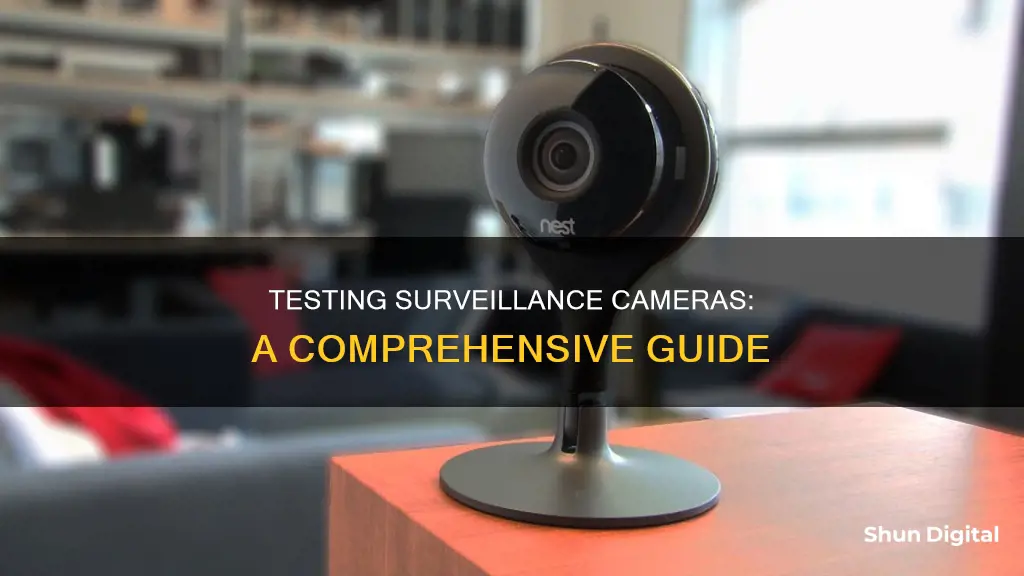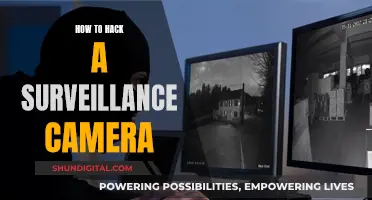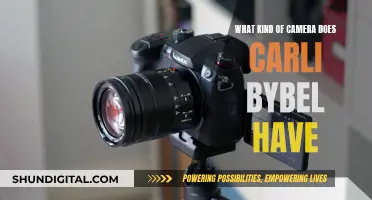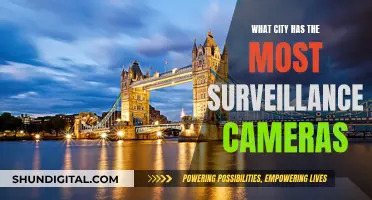
Surveillance cameras are an excellent way to monitor your property, deter intruders, and provide evidence in the event of a break-in. However, regular testing and maintenance are crucial to ensure they function properly. Here are some essential steps to test your surveillance camera system and maintain optimal security:
- Check Camera Positioning and Focus: Ensure cameras are pointed in the right direction, installed at the correct height and angle, and free from any obstructions. Use a monitor or viewing software to adjust the focus if needed.
- Inspect Image Quality: Evaluate the lighting conditions, check for blurriness or distortion, and adjust the camera's image settings for optimal clarity.
- Test Recording and Playback: Verify that cameras are recording properly and that footage is stored correctly. Ensure motion detection works as intended, and confirm that recorded footage can be accessed and played back without issues.
- Examine Camera Movement: For pan and tilt security cameras, observe if they rotate continuously and emit a distinct buzz when in operation.
- Verify Status Indicators: Look for small red or blue lights around the lens, indicating that the camera is active or recording.
- Utilize Security Camera Testers: Portable security camera testers are available to facilitate installation, maintenance, and testing. These devices can perform various tests, including Ethernet performance, monitor performance, and resolution checks.
- Detect Hidden Cameras: If you suspect hidden cameras, use methods like manual inspection, smartphone apps, RF detectors, infrared scanners, or Wi-Fi network scanning to uncover any concealed devices.
By following these steps and staying vigilant, you can ensure your surveillance camera system operates effectively, providing peace of mind and enhanced security.
| Characteristics | Values |
|---|---|
| Camera positioning | Pointed in the right direction, installed at the right height and angle, no obstructions |
| Camera focus | Focused on the area to be monitored, with clear footage |
| Image quality | Good lighting, no blurriness or distortion, optimised image settings |
| Recording and playback | Proper recording, enough storage space, functional motion detection, accessible playback |
| Video quality | 1080p or higher resolution, 130º field of view, 15 fps frame rate, 30 feet night vision range |
| Video storage | 32 GB or higher local storage, 14 days or more cloud storage |
| Security camera features | Mobile app, motion detection, two-way audio, smart home controls |
What You'll Learn

Check camera positioning and focus
When installing a surveillance camera, it is important to get the positioning and angle right to ensure maximum coverage and clear footage. Here are some tips to help you get the best out of your camera:
Determine the places for cameras:
Firstly, identify the places where you want to install cameras. These should be areas where there are assets that need protection, or "choke points" towards these assets. For example, in a convenience store, the assets are the cash register, safe, liquor section, and stockroom. The choke points are the front and back entrances. So, you would typically place cameras to cover these areas.
Determine the type of cameras:
There are three general types of cameras: fixed cameras, mechanical PTZs, and panoramic cameras. Fixed cameras are suitable if you have a very specific area of interest and no operator watching in real time. Mechanical PTZ cameras are a good choice if you have a large area of interest (more than 200 sq. ft./25 sq. m) and an operator monitoring the feed. Panoramic cameras are ideal for small areas without an operator watching in real time.
Verify the camera's field of view:
Make sure the camera is capturing the desired area effectively. The camera's angle can affect its field of view and the quality of the footage. A camera positioned too high may capture too much sky, while one positioned too low may only provide a close-up of the ground. The angle should be adjusted to avoid blind spots and ensure all crucial entry points are in view.
Adjust the camera height:
When it comes to height, eye level (around 6 feet off the ground) is generally best. This provides a good field of view and makes it more difficult for potential intruders to tamper with the camera. However, consider any obstructions that may block the camera's view, such as trees or buildings, and adjust the height accordingly.
Position the camera 45 degrees down:
Mount the camera at an elevated height and angle it 45 degrees downward. This allows the camera to capture maximum activity while also maximising the field of view. Ensure the camera lens is level with the ground to avoid unnecessary footage of the sky. Adjust for any obstructions and consider using a zoom lens for clearer footage if needed.
Aim for overlap:
Each camera's field of view should overlap with adjacent cameras to ensure there are no blind spots. A good guideline is to have a 10-20% overlap between cameras, so any movement is captured by at least two devices.
Adjust the camera angle for different times of day:
The lighting conditions can impact the camera's effectiveness. During the day, position the camera to capture wider areas, avoiding direct sunlight to prevent glare. At night, adjust the angle to accommodate low-light settings and maximise the range of night vision. For low-light conditions, you may need to increase the camera's sensitivity or reduce its shutter speed.
Use camera positioning tools:
Utilise tools such as smartphone apps or laser levels to help you find the perfect angle for your camera. Many camera manufacturers offer dedicated apps that provide a live preview of the camera's field of view, making it easier to achieve the desired coverage.
By following these tips, you can ensure your surveillance camera is positioned correctly and provides the maximum coverage and clearest footage possible.
Mastering Pixel Camera Focus: Tips for Sharp Photos
You may want to see also

Check image quality
When testing the image quality of a surveillance camera, it is important to look beyond video resolution. Here are some factors to consider when evaluating the image quality of a surveillance camera:
Video Resolution
A higher video resolution will provide more detail, allowing you to better identify people and objects. A resolution of 1080p or higher is generally recommended as it provides enough detail to distinguish facial features, clothing, and actions. It also looks better on larger screens such as computer monitors and TVs, so you're not limited to viewing footage on a small phone screen.
Field of View
The field of view is the area that the camera can see. It is typically measured in degrees and determines how much of the scene the camera can capture. For example, a field of view of around 130º is suitable for indoor and outdoor use, while a wider viewing angle of about 160º is preferable for a video doorbell or outdoor security camera to provide complete coverage of your property.
Frame Rate
The frame rate refers to the number of frames or images captured by the camera per second. A frame rate of at least 15 frames per second (fps) is recommended for smooth motion in videos. For results closer to what you would expect from a TV, choose a camera with 24 fps or higher.
Night Vision
Night vision is an important consideration if you need to monitor areas with low lighting conditions. Look for a camera with a night vision range of at least 30 feet for indoor use and 60 feet or more for outdoor use. Many security cameras use infrared LEDs to record in complete darkness, but some models also have a secondary spotlight, which can deter intruders and provide colour night vision.
Image Sensor
The image sensor is a hardware component in the camera that captures light and converts it into an electronic image. There are two types of image sensors: CCD and CMOS. CCD is an older technology that performs better in low light, has lower white noise, a wider dynamic range, and higher definition. However, CCD sensors are more expensive, consume more power, and have lower frame rates. CMOS image sensors, on the other hand, are more compact, less expensive, produce higher frame rates, and deliver better colour.
Compression Technology
Video compression is used to reduce the file size of the recorded footage to optimise storage space. However, this can sometimes result in a loss of image quality. H.264 is the standard compression format used in security camera systems, but newer technologies like H.265 offer better image quality and more efficient storage usage.
Focusing on Camera Images with OpenCV
You may want to see also

Test recording and playback functions
Testing the recording and playback functions of your CCTV system is crucial to ensure that your cameras are properly recording and storing footage, and that you can easily access and view that footage in the event of a security incident. Here are some detailed steps to test these functions:
Check the Recording Function:
- Ensure that your cameras are recording properly: Verify that footage is being captured and stored in the correct location.
- Check storage space: Make sure there is sufficient storage space available for the recorded footage.
- Test motion detection: Confirm that your cameras are recording when they detect motion, as this is a crucial feature for security purposes.
Check the Playback Function:
- Access recorded footage: Use the playback function to access and view the recorded footage.
- Verify clarity and accuracy: Check that the recorded footage is clear, accurate, and free from any blurriness or distortion.
- Test all cameras: Ensure that the playback function works for all your CCTV cameras and not just a select few.
Common Issues and Fixes:
- Check camera settings: If you encounter issues with recording or playback, verify that your camera settings are configured correctly.
- Update firmware and software: Keep your CCTV system's firmware and software up-to-date to avoid compatibility and functionality issues.
- Consult manufacturer's support: If problems persist, refer to the manufacturer's manual or contact their customer support team for assistance in troubleshooting and resolving the issues.
By thoroughly testing the recording and playback functions of your CCTV system, you can be confident that your security cameras are reliably capturing and storing footage, and that you can readily access and review the recorded content when needed.
Spotting Fake Surveillance Cameras: What to Look For
You may want to see also

Inspect for common signs of hidden cameras
To inspect for common signs of hidden cameras, you can try the following methods:
Manual Inspection
Use a flashlight to carefully scan the room, keeping it at eye level, and look for tiny blue, purple, or red reflections that shine when hit by a ray of light. These reflections are likely to be camera lenses. You can also use your phone flashlight to check inside smoke detectors, air vents, and outlets for hidden cameras.
Investigate LED Lights
Small lights shining in a dark room could indicate a hidden camera. Unplug the device if possible, or look up the device online to find out what the light is for.
Look for Out-of-Place Objects
Check for decorative items that may seem out of place, such as random stuffed animals in a modern Airbnb. Inconspicuous objects like alarm clocks, smoke detectors, and picture frames can be used to hide cameras.
Scrutinize Wires
With so many IoT devices and electronics, it's easy to overlook wires. However, these could be connected to hidden cameras that require electrical power.
Search for Holes
People can tuck cameras away in small holes, so check for gaps in walls, furniture, decor, and fixtures where a camera might be hidden.
Test Mirrors
Place your finger against the mirror to check for hidden cameras. If there's a gap, it's likely a real mirror; if your finger and reflection seem to touch tip to tip, it could be a two-way mirror or masking a hidden camera.
Use a Smartphone Camera and Apps
If your phone has an infrared light camera, you can use it to find hidden cameras by scanning the room for small bursts of steady or flashing lights. Smartphone apps that use technologies like Bluetooth scanning and infrared detection can also help find unidentified devices within range, but avoid downloading these apps from third-party app stores to avoid malware.
Use an RF (Radio Frequency) Detector
RF detectors provide an audible or visual alert when they pick up on a hidden camera's signal, helping you locate it. These devices scan for radio frequencies emitted by hidden cameras and can be purchased online or in stores, with prices starting at around $20.
Use an Infrared Scanner
Infrared scanners can aid in hidden camera detection by picking up the invisible infrared light emitted by certain night vision cameras. Sweep a darkened room with the scanner, and if you notice a faint glowing spot, it could be a camera lens reflecting the infrared rays.
Scan Wi-Fi Networks
Some hidden cameras connect to Wi-Fi so users can monitor them remotely. If a hidden camera is connected to the same network as you, you might detect it by scanning your wireless network for unrecognized devices or those with suspicious names like "IPcamera" or "InteriorCam."
Blur Surveillance Cameras: Easy Tricks to Try
You may want to see also

Check camera movement
To check the movement of your surveillance camera, you need to establish if it is a pan and tilt camera. This type of camera will rotate continuously when it is on, and you will hear a distinct buzzing sound as it rotates. If you have set up the patrol/tour function, you will see it moving constantly.
If you have a fixed camera, you will need to check the field of view. The viewing angle of a camera is called the field of view, and this will determine how much of an area the camera can see. The field of view is measured in degrees, and the higher the number, the wider the angle of the footage. A camera with a field of view of 130º will be able to see a large area, both indoors and outdoors, while keeping subjects a reasonable size within the video frame. A video doorbell or outdoor security camera might have a wider viewing angle of 160º, so you won't need as many cameras to cover your property.
You can also check the movement of your camera by testing its motion detection capabilities. Motion detection is now a standard feature in most home security cameras. You can set up specific motion zones and adjust the sensitivity of the motion detection. Some cameras will also allow you to set up separate alerts for people and vehicles. More advanced cameras will use artificial intelligence to recognise faces and notify you of unfamiliar people.
If you want to test the movement of your camera, you can walk in front of it and see if it follows you. You can also test the motion detection by setting up zones and seeing if you get an alert when you enter them.
The Evolution of Cameras: A Historical Perspective
You may want to see also
Frequently asked questions
There are several ways to check if a security camera is on, including observing whether the camera is moving, checking the status of the LEDs, logging into your security camera software, and using electronic bug detectors.
Check the lighting conditions in the areas being monitored and ensure the cameras are adjusted to the correct settings. Install additional lighting if necessary. Look for any blurriness or distortion in the footage and adjust the camera's focus or replace the lens if necessary.
Check that your cameras are recording properly and that the footage is being stored in the correct location. Ensure there is enough storage space and test the motion detection feature. Test the playback function to ensure you can access and view the recorded footage, and that it is clear and accurate.
A good security camera should have a video resolution of 1080p or higher, a field of view of around 130º, a frame rate of at least 15 frames per second, and a night vision range of 30 feet or more. It should also have local or cloud storage options, a mobile app for remote access, and motion detection capabilities.







